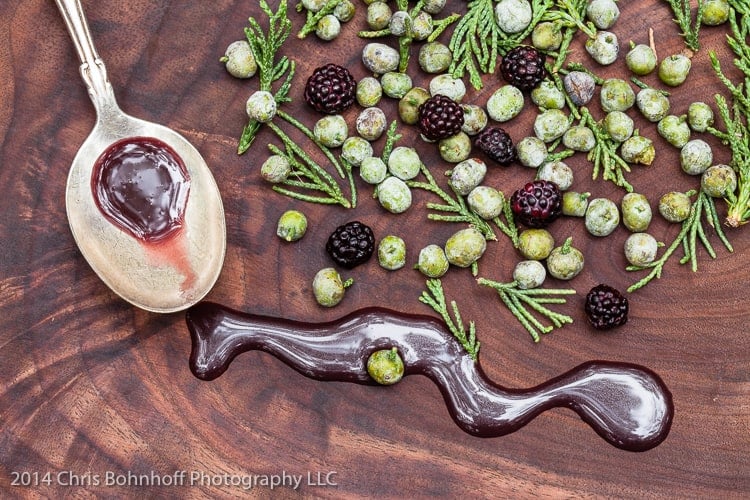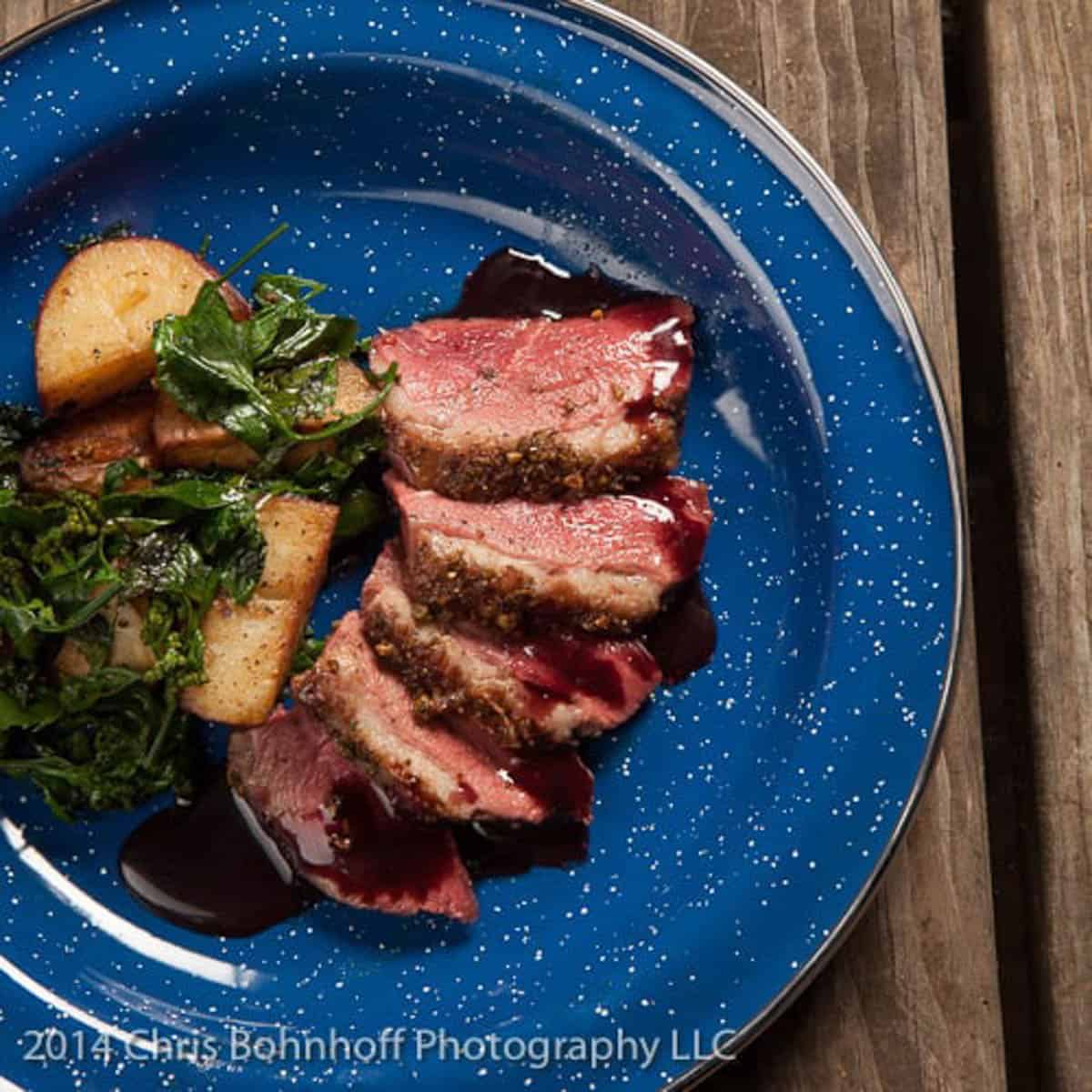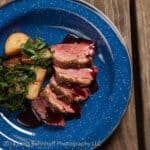Crisp duck breast seasoned with wild juniper with a sauce of black cap raspberries. You don't have to be around a campfire to make this, but it made a great meal to eat around the fire as the day faded to night.

I seasoned the duck breast with some wild juniper/cedar berries, and cooked it slowly in a cast iron skillet to crisp the skin. After the duck was half cooked, I removed the fat to another pan to cook some potatoes and lambs quarter, then garnished the whole thing with a sauce made from wild black cap raspberries cooked in duck stock.

Wild Cedar Duck Breast With Blackcap Berry Sauce
Serves 4 as an entree
Servings: 4
Ingredients
- 4 large skin on duck breasts
- Fresh wild juniper/cedar berries finely minced to yield 4 tsp
- 2 cups wild blackcap raspberries
- 3 tablespoon maple syrup
- Kosher salt and pepper
- 1 lb heirloom potatoes any variety, quartered
- 1 quart duck or meat stock
- 1 cup dry red wine
- 5 tablespoon unsalted butter
- ½ lb wild spinach/lambs quarter washed and dried, tender tips only,
Instructions
- In a small sauce pan, heat the stock, black cap berries, red wine and maple syrup. Cook the mixture for an hour on low heat (this can be done while you're prepping other ingredients. When the liquid is reduced by half, about 30 minutes, strain the berries and sauce through a sieve or strainer, pressing on the berries with a spoon to pass their flesh through which will help add body to the sauce and thicken it. Put the strained sauce back in the sauce pot and continue to cook on medium-low heat, allowing it to reduce slowly while you cook the potatoes and the duck.
- Season the duck breasts with salt and pepper. Press 1 teaspoon of the wild juniper onto the skin of each duck breast. In a large pan, render the fat from the duck breasts on medium heat until the skin is golden brown and caramelized. Drain the fat as it renders from the duck and transfer to another pan to cook the potatoes. Remove the duck breasts from the heat.
- Heat the pan with the rendered duck fat and add the cut potatoes. Season the potatoes with salt and pepper and cook until the potatoes are lightly caramelized and browned on each side and cooked through, about 15 minutes on a campfire. Place the pan with the potatoes in a spot with ambient heat and keep warm.
- When the potatoes are cooked, put the pan with the duck breasts back on the heat and continue to cook, skin side down until the skin is crisp. Add 4 tablespoon of butter to the pan and allow it to melt and foam. Baste the duck breasts with the foaming butter until they are cooked medium rare. When the duck breasts are cooked, flip them over and cook for 3o seconds on the flesh side, just to ensure the tendon running through the tenderloin is cooked through. Remove the duck breasts to a cutting board and allow to rest for 5 minutes, skin side up before carving and serving.
- Finishing and plating
- When you're ready to carve the duck and plate, add the wild spinach and 1 tablespoon of butter to the potatoes, toss the mixture to wilt the greens and remove from the heat.
- Finish the sauce by bringing it back up to a simmer. Whisk in the butter and cook for 2 minutes more, whisking constantly to thicken the sauce and create a creamy emulsion. Check the seasoning one last time for salt and sweetness (maple syrup).
- To plate, place a mound of potatoes and greens on each of four preheated dinner plates. Carve each duck breast into ½ inch slices and fan around the potatoes, spoon some sauce over each duck breast and serve immediately.
Notes
I should mention that some species of cedar berry I've tried are very bitter. Make sure to taste some of the berries before you cook with them, and even with less bitter versions, use a light hand since the flavor is very strong. You can also just substitute regular juniper from the store, but be careful since dried berries will burn more easily as you render the fat from the duck.
I served the dish with some potatoes cooked in duck fat, and wilted lambs quarter. Make sure to add a little butter to the pan at the end when you add the lamb's quarter, the moisture in the milkfat helps it to wilt without scorching.


Andy Vermouth
Dude, yer killin' me with this with some berries I got a few weeks back. I'm making if for Xmas Eve dinner on a fire in the backyard, but probably substitute my own honey for the maple syrup. Greetings from the Front Range of CO.
Alan Bergo
How did it turn out? Nice to hear you make your own honey, good for you!
Andy Vermouth
Oops, just saw this... almost a year later. Turned out awesome. I'ma do it again this year. Sold out of all my honey. Next season, re-up on a bunch of hives in the city here for a varietal Linden that people (and restaurants) around here love.
Loretta
This recipe sound great, now if I could find some duck breasts. I just returned empty handed (not totally as did get some goat, sausages and the like) from Cleveland's West Side Markets where I have bought them before. But I'll save this recipe for future use. Thanks for posting such wonderful recipes.